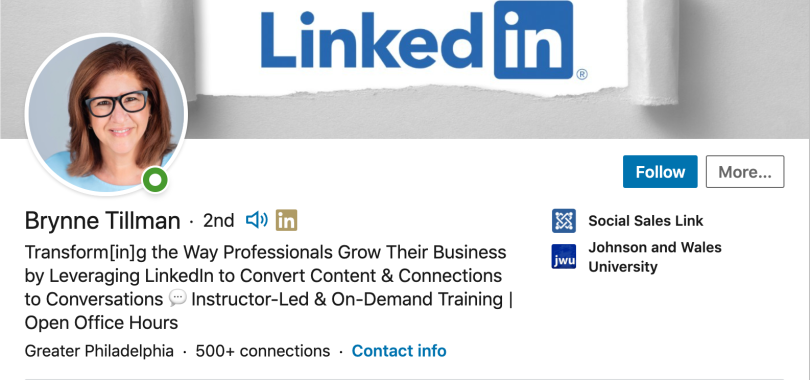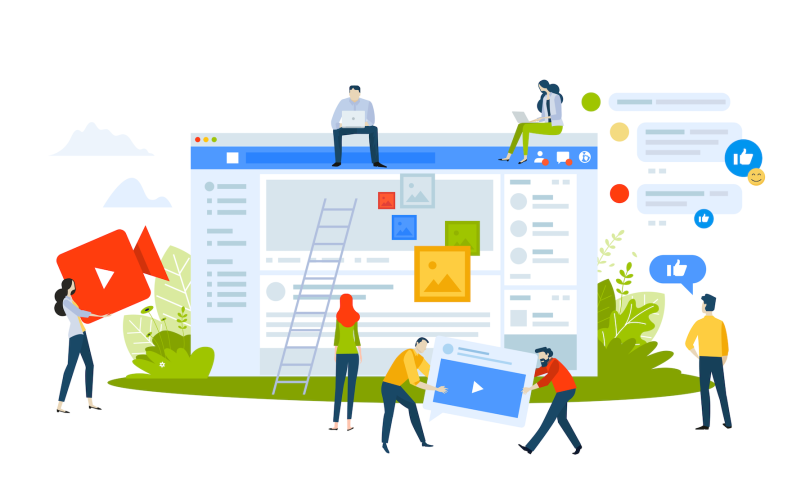Koka Sexton built his career on social selling, but, before that, the strategy almost got him fired.
It was the early 2000s, and Sexton was working as a sales rep for a disaster recovery software company. Each day, he’d pick up the phone and call buyers from a list provided to him from the marketing team. One by one, his calls would go ignored until he’d luck into a conversation or two. Then, he’d do it again the next day.
He knew there had to be a better strategy, but at the time, cold calling dominated the industry. Then, the professional networking website LinkedIn arrived, and with it, a new era of sales.
Five Quick Social Selling Tips
- Turn your LinkedIn profile into a resource that provides buyers with two or three key insights.
- Provide content that is relevant to your buyers. Research their profiles to learn what content they like and share.
- Post content three times a day — in the morning, afternoon and evening. This will increase your exposure to people in your network.
- Wait until a connection has engaged with your posts multiple times in a month to schedule a call. During the call, talk about what you have in common, not the product you offer.
- Track social media activity in the CRM. This can help sales managers determine the ROI on social selling.
After witnessing the reach early social media influencers had — and reading Nigel Edelshain’s influential blog, Sales 2.0, on digital selling — Sexton decided to gamble that his activity on LinkedIn could translate into revenue.

So, he stopped cold calling and started posting on LinkedIn to attract the attention of buyers. The strategy worked, but his metrics were terrible. He ranked near the bottom in number of dials and time spent on the phone, despite always being top five in revenue.
“My boss would look at me and say, ‘How the fuck are you doing this?,’” Sexton said. “He said, ‘If you don’t pick [your metrics] up, we’re going to have to figure out what to do with you.... You’re not playing the right game.’ I was like, ‘Well, your game is wrong.’”
“He said, ‘If you don’t pick [your metrics] up, we’re going to have to figure out what to do with you.... You’re not playing the right game.’”
Sexton went on to prove his boss wrong, first promoting social selling on a national scale in a role at LinkedIn, and now as the founder of a social sales consulting firm. Meanwhile, social media has become such an integral part of the sales process that the term “social selling” has become redundant, Sexton said. Instead, it’s just another part of the sales process, along with cold calling and email.
But sales’ transition to social media platforms like LinkedIn has created another challenge: How do you stand out from the noise?

What Is Social Selling?
Sales has always been about building relationships. Social selling extends that to the world of social media.
What’s the difference between digital selling and social selling?
- Digital Selling: The process of selling through digital media, which includes social media, Google search, email and more.
- Social Selling: A subset of digital selling that involves using social media to build relationships with buyers.

Nigel Edelshain was among the first people to popularize the process in his blog Sales 2.0 in 2006. At the time, Edelshain ran an outsourced telesales firm. He had long been looking for a way to increase leads and boost cold call conversion rates, and he found his answer in LinkedIn.
To him, the website was more than just a place to upload a resume — it was an interconnected web of customer contacts. For the first time, a company didn’t need to spend a day researching a firm or hope for a referral lead. Instead, if a rep posted the right content and connected with the right buyers, they could gain access to an exponential amount of customers, Edelshain told Built In.
“When I looked at LinkedIn, it wasn’t just that it was a giant CRM — it was that it was the holder of the social graph for business,” said Edelshain, who’s now the COO at Big Fish Digital Solutions. “That’s the place you go to try to figure out who I know or who you know.”
In practice, Edelshain had his sales reps posting, liking and sharing content that customers would find valuable on LinkedIn to earn their trust. Once a buyer engaged with his rep’s content multiple times, the salesperson could use that as an opportunity to expand their network and take the conversation offline.
The strategy reflected the new way buyers were engaging with salespeople. Rather than learning about a product through the sales call, they preferred to do their research online. Social sales allowed salespeople to play an active role in that conversation where the buyers were.
“When I looked at LinkedIn, it wasn’t just that it was a giant CRM — it was that it was the holder of the social graph for business.”
Initially considered a fad, social selling has proven itself to work. Sales teams that generated leads on social media experienced 18 percent greater pipeline volume and a quicker sales cycle, according to a report from the digital sales consulting firm Sales for Life.
What Does It Look Like in Action?
Social selling doesn’t mean reps need to suddenly become social media influencers, or even social media experts.
The skills that make a successful salesperson are the same ones that make a great social seller: listening, empathy and industry expertise, said Jill Rowley, a longtime social sales practitioner at major tech firms, including Salesforce and Eloqua.
“If you suck offline, you’re going to suck more online,” Rowley said. “If you don’t show the buyer you know them and you don’t help them offline, you’re not going to do it online. Social is just another way to find your buyers and relate to them.”
Understanding what content buyers share and engage with will help a salesperson provide relevant content, which is critical to standing out from the crowd of other reps posting online, Rowley said.
“If you suck offline, you’re going to suck more online.”
But it’s also important to know that building the right connections on social media takes time. Sometimes, connecting a buyer to someone else who can help them will strengthen the relationship, even if it doesn’t lead to a deal. Eventually, that contact will either be interested in a deal, or, just as valuable, offer a referral to another source in their network.
Ultimately, unlocking the full potential of social selling requires generating visibility, creating value and fostering relationships. That starts with the profile.
Your LinkedIn Profile (Probably) Needs a Makeover
The first step toward gaining an edge in social selling is to transform your LinkedIn profile from a resume into a resource.

Since your profile is the first place a buyer will look, it’s also the first opportunity for a rep to provide value, said Brynne Tillman, founder of Social Sales Link. The more value a salesperson can provide upfront, the more likely the prospect is to connect with them.
“I’m asking you to spend five minutes to read my profile, and at the end of those five minutes that you can never get back, I want you to be better for having been there,” Tillman said. “If you can do that, you are positioned to convert your content and connections into sales conversations.”
The biggest mistake Tillman sees reps make on their profiles is listing what their companies do and how they help businesses. Instead, the profile needs to provide actionable insights.
When it comes to figuring out what information to include, Tillman has a simple thought exercise that she teaches reps: “You’re given $5,000 to talk on a panel. What will you talk about?” The answer to that question should form the talking points for the rest of the profile.
On LinkedIn, the value building starts in the box under a person’s name. Most salespeople overlook this section, assuming it’s meant for their job titles, Tillman said. However, at 210 characters, the space should be used more like a headline to tell the buyer who you help and how you help them.
Her profile looks like this:

From there, the about section should drill deeper, offering two or three insights that will make the buyer’s “jaws drop,” along with an email and calendar link to schedule a meeting, Tillman said. She recommends staying away from providing any personal mission statements in this section.
“That’s like walking up to someone in the bar and saying, ‘Will you marry me?’ It’s too soon,” Tillman said.
The job section is the rep’s opportunity to tell their story and explain their mission in a narrative format. Ultimately, the more carefully the profile is designed to help the buyer, the higher a rep’s engagement rate will be.
“The more you brag about what a great salesperson you are, the less this will work in your favor,” Tillman said. “But if you can tell stories about the difference that you’ve made, people get sucked in.”

Content Sharing Do’s and Don’ts
Posting on LinkedIn is all about two key goals: providing value and increasing visibility with buyers.
Sharing the right content garners likes from buyers. When someone likes your post, it gets passed on to people in their contact list, which can slingshot it to even more buyers. But this strategy can easily go wrong. If the balance isn’t right, a rep can end up posting content that no one sees, or that goes ignored because it doesn’t provide value.
Below is a helpful guide for what you should be posting and when.
Do post three times a day.
One of the biggest mistakes reps new to social selling make is not posting enough — often out of fear of annoying buyers, Sexton said. As a result, their posts often get drowned out. Sexton suggests getting in the habit of posting three times a day — ideally in the morning, afternoon and evening. In doing so, the salesperson will eventually seem ever-present in a person’s social media feed. And if the content is valuable, it won’t be considered an intrusion.
Do share content that your buyers find valuable.
When it comes to figuring out what content to post, the best place to start is by researching what customers are engaging with on LinkedIn. From there, Sexton suggests curating stories that are relevant to those buyers. Don’t be afraid to share content from other blogs or industry websites. If it’s a network of technologists, perhaps that’s content about how to reduce server downtime. If you have more experience, he recommends providing some insight in addition to the story. Finally, if a rep has a point of view and enough knowledge, they can share their own content — as long as it provides value to the customer.
Do interact with other posts through likes and comments.
Beyond posting content, it’s important to spend time liking and commenting on other posts. Clicking the “Like” button and engaging with other people’s content can be a great way for a salesperson to expand their network, Tillman said. Those conversations can frequently lead to offline conversations and potential sales opportunities.
Do share content directly with buyers and tag names.
It can be difficult to generate an audience for your posts when you don’t have a lot of connections. When Tillman looks for content, she does so with a group of buyers in mind. She’ll then go to their profile pages and share the story directly with them.
“I’ll say, ‘Just read this article from HubSpot, and it made me think of you because it really is a powerful piece for CMOs. Hope you enjoy,’” Tillman said. “And that’s it. We don’t have to sell all the time.”
Another way to generate an audience is to tag people’s names in posts that are relevant to them. Once a week, Sexton takes the alerts from LinkedIn about people changing jobs and congratulates each person on their new positions. The posts are a quick way to engage with your network and expand your visibility into a new network of prospects. However, it’s important to exercise caution when tagging people. Calling someone out to comment, for example, is a great way to put a person on the spot and lose their respect, Sexton said.
Don’t post only about your company.
There’s nothing that will cause prospects to tune out more than marketing content. When Sexton reflects on his most embarrassing mistakes starting out in social selling, it was when he only posted about his company. Instead, he recommends reps to take an 80-20 approach, in which 80 percent of the content a rep shares should be unrelated to their company. The most effective posts should simply be aiming to provide value to customers, not selling.
Don’t hack the algorithm.
As social selling grows in popularity, there are more people looking to play LinkedIn’s algorithm to build a larger audience. The most common example of that is the “Bro Post,” which involves a rep sharing a personal story in one-sentence paragraphs in an attempt to go viral. While it can be a useful technique when a rep has an insight to share, it’s often used to build a following. When that’s transparently the case, Rowley loses a little respect for the sales rep. As a general rule, gaming the system to build a bigger network isn’t a good use of time, she said. Instead, she encourages reps to deepen their relationships with existing customers.
“When you optimize for the algorithm, you’re going beyond the role of the salesperson,” Rowley said.
Don’t write about something unrelated to your work.
Posting content that doesn’t provide value can be just as bad as not posting at all. Tillman recalled a salesperson who gained a large following by only sharing Albert Einstein quotes. To measure the effectiveness of her strategy, the rep did a study with Tillman where she reached out to 15 of her most frequent commenters and asked them if they knew what she did without looking at her profile. Not a single person knew what she did. The result underscored the importance of providing relevant content, Tillman said.
“We shouldn’t lead with our solution, which is a pitch, but we need to lead to our solution by providing value that allows people to identify us as a subject matter expert and resource,” Tillman said.

How to Take the Conversation Offline
While the purpose of building relationships with customers on LinkedIn is to turn them into buyers, it’s important not to rush the relationship-building process. Sending a pitch too soon is a quick way to lose a follower, Sexton said.
At the same time, it can be easy for those relationships to live only on LinkedIn. Eventually, a rep needs to turn that relationship into a revenue opportunity — there is a quota to fulfill, after all.
In order to know when to reach out to a customer, Sexton suggests following a flow chart. When a connection is first made, Sexton thinks of them as a “fan,” or someone interested in the content he is sharing. They’re not a customer yet, so it’s important to continue having conversations with them online.
“You’re not selling them anything, you are literally just building social capital and moving it from this online environment to an offline one.”
The next milestone is whether or not a follower has engaged with your posts. If the answer is “Yes,” then how often? If a contact is commenting a few times a week or a couple times a month, then a rep can reach out to set up a call, Sexton said.
But even then, he suggests talking about shared interests and offering insights rather than having a formal sales call.
“You’re not selling them anything. You are literally just building social capital and moving it from this online environment to an offline one,” Sexton said. “If that leads into a sales conversation, fine, but you should actually actively try to push away from that.”
What Social Selling Metrics Should a Sales Leader Track?
The biggest pain point in Sexton’s career has been explaining the metrics around social selling strategies. Even sales managers who believed in social selling had a hard time understanding why one rep was successful at it while another wasn’t, Sexton said.
“They’re like, ‘I don’t know how Jack Koskowski is doing this, but he’s definitely making his number,’” Sexton said. “They’re like: ‘I can’t just measure the fact that he’s posting 17 times a day. That doesn’t do anything. What does that mean?’”
As social selling has matured, a few metrics have emerged. If a company doesn’t use LinkedIn Sales Navigator, they can track the impact social media relationships have through their CRM, Sexton said.
“When companies started implementing that, on a very basic level, they’re like, ‘Holy shit, these things are accelerating deals.’”
Sales managers can start with asking reps to log social activity with their account sources. He also suggests that they track how many connections a rep makes each week on LinkedIn, and of those connections, how many were ideal customers. Over time, they can pull that data and see how many leads were generated from social selling activity.
“When companies started implementing that, on a very basic level, they’re like: ‘Holy shit, these things are accelerating deals. We’re seeing deal cycles on this specific use case shortening by weeks,’” Sexton said.

Social Selling on LinkedIn Isn’t Going Anywhere
Sexton would like to tell you that he saw social selling becoming a ubiquitous part of sales when he started out. Actually, he admits that his younger self would be arrogant enough to claim that this is exactly how it would play out.
But really, he just knew that something had to change when it came to how sales worked. And if social media was already reshaping personal relationships, why wouldn’t it change sales?
Still, now that the secret is out, some are concerned that LinkedIn has become too flooded with sales posts. After all, there was a time when email and cold calling worked too. Rowley has noticed that the platform has become noisy with blatant sales pitches. And sales leaders I’ve talked to in the course of reporting other stories commonly complain that their LinkedIn mailboxes are full of “junk” from salespeople.
“Many people are finally realizing that they need to have this brand, because when everybody’s working from home, all you have is that name.”
At the same time, LinkedIn remains the main place buyers congregate. And, as reps sell from home due to COVID-19, those social relationships have grown in importance as a necessary personal touchpoint. What does this mean for the future of social selling?
Sexton believes the next step for reps is to build their professional brands on LinkedIn. Without the professionalism an office environment gives a salesperson, that brand lends credibility. It starts with being strategic about the content you share to position yourself as a thought leader to buyers, discovering unique ways to engage with users and telling your story.
“Many people are finally realizing that they need to have this brand, because when everybody’s working from home, all you have is that name,” Sexton said. “If nobody knows who you are, it’s going to put you at a disadvantage.”




